| Article ID | Journal | Published Year | Pages | File Type |
|---|---|---|---|---|
| 4996257 | Biomass and Bioenergy | 2017 | 12 Pages |
Abstract
Cassava-based ethanol has been promoted in China and Southeast Asia as an effective means to reduce greenhouse gas (GHG) emissions and promote energy security. However, existing life cycle assessments of the environmental impacts of cassava ethanol have used highly-aggregated empirical methods to estimate ecosystem C stock changes, which do not capture finer-scale characteristics of different cassava growing regions within a country. We investigated carbon debts, GHG emissions, and payback periods for cassava-based ethanol in Vietnam using a life cycle assessment approach coupled with the widely-used ecosystem biogeochemical CENTURY model. The model simulated regionally-specific carbon stock changes associated with cassava cultivation for biofuel feedstock under different land use change, cassava yield and fertilization scenarios. We found that switching land use to cassava production for biofuel substantially reduced soil organic carbon in all major cassava growing regions in Vietnam. GHG emissions, carbon debts, and payback periods of Vietnam's cassava ethanol were strongly dependent on cassava yield. The mean carbon debt due to direct land use change to cassava production for ethanol ranged from 66 to 97 Mg of CO2 per hectare, and the net carbon dioxide equivalent emission of cassava-based ethanol ranged from 36 to 95 g MJâ1, depending on the range of cassava fresh weight yield (from 18 to 60 Mg haâ1). To repay a carbon debt from direct land use change within 25 years, the average fresh weight yield of cassava used as feedstock for ethanol production must be above 33 Mg haâ1.
Keywords
Related Topics
Physical Sciences and Engineering
Chemical Engineering
Process Chemistry and Technology
Authors
Trung H. Nguyen, Stephen Williams, Keith Paustian,
